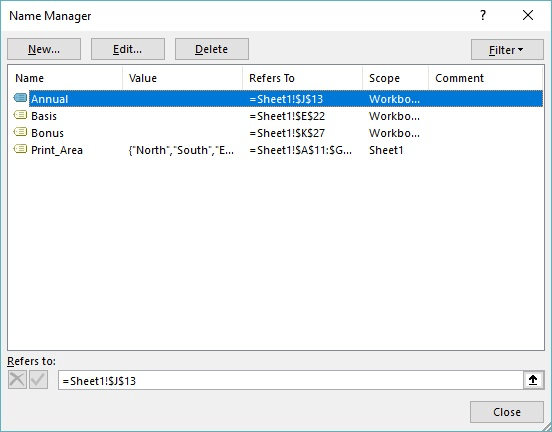Please Note: This article is written for users of the following Microsoft Excel versions: 2007, 2010, 2013, 2016, 2019, 2021, 2024, and Excel in Microsoft 365. If you are using an earlier version (Excel 2003 or earlier), this tip may not work for you. For a version of this tip written specifically for earlier versions of Excel, click here: Changing the Reference in a Named Range.
Written by Allen Wyatt (last updated June 14, 2025)
This tip applies to Excel 2007, 2010, 2013, 2016, 2019, 2021, 2024, and Excel in Microsoft 365
Using named ranges can be very handy when you are working with formulas or when you just want to keep track of what certain cells in a worksheet are used for. At some point, however, you may want to change the cells referred to by an existing named range. For instance, if a named range called MyRange refers to cells A1:A5, you may want to have it refer to cells C7:C19 instead.
The easiest way to change the range to which a name refers is to use the Name Manager. You can display the manager by displaying the Formula tab of the ribbon and clicking the Name Manager tool in the Defined Names group. (See Figure 1.)

Figure 1. The Name Manager.
The Name Manager lists all the named ranges that you've defined. You might think that you need to click Edit in order to make a change, but when changing the actual range associated with a name the process is even easier:
That's it; MyRange now refers to cells C7:C19 instead of A1:A5.
ExcelTips is your source for cost-effective Microsoft Excel training. This tip (8237) applies to Microsoft Excel 2007, 2010, 2013, 2016, 2019, 2021, 2024, and Excel in Microsoft 365. You can find a version of this tip for the older menu interface of Excel here: Changing the Reference in a Named Range.

Excel Smarts for Beginners! Featuring the friendly and trusted For Dummies style, this popular guide shows beginners how to get up and running with Excel while also helping more experienced users get comfortable with the newest features. Check out Excel 2019 For Dummies today!
Creating math formulas is a particular strong point of Excel. Not all the functions that you may need are built directly ...
Discover MoreWhen analyzing data, you may need to distill groupings from that data. This tip examines how you can use formulas and ...
Discover MoreNeed to find out how many times a certain letter appears in a text string? It's easy to do if you rely on the SUBSTITUTE ...
Discover MoreFREE SERVICE: Get tips like this every week in ExcelTips, a free productivity newsletter. Enter your address and click "Subscribe."
There are currently no comments for this tip. (Be the first to leave your comment—just use the simple form above!)
Got a version of Excel that uses the ribbon interface (Excel 2007 or later)? This site is for you! If you use an earlier version of Excel, visit our ExcelTips site focusing on the menu interface.
FREE SERVICE: Get tips like this every week in ExcelTips, a free productivity newsletter. Enter your address and click "Subscribe."
Copyright © 2025 Sharon Parq Associates, Inc.
Comments